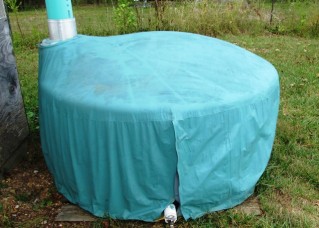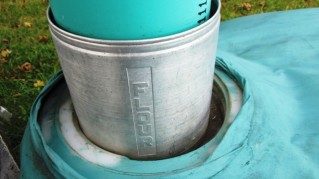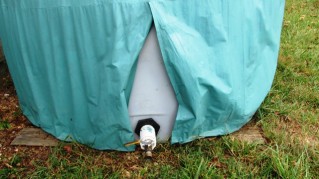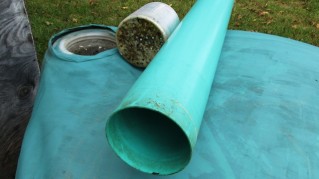Around here, water falls freely from the sky, on average, once every 10 days or so, yet for nearly all my life, I failed to retain the rain. Yes, rainwater is still free in the Ozarks.
The practice of collecting rainwater dates back at least 3,000 years, and is still used in many remote areas worldwide. In hot, dry South Australia, for example, more than half the population relies on rainwater for some or all of their water needs. Throughout Australia, 16 percent of households use rainwater tanks, with 13 percent of households using tanks as their main drinking water source from 1994 to 2001. Yes, I said for all their drinking water, unfiltered and untreated.
According to a 1994 survey, many Australians said they use rain tanks to independently collect a relatively pure product and use it without treatment, especially without adding chemicals. The general public perception is that rainwater is safe to drink. In remote parts of Australia, using rainwater tanks to supply drinking water has been a long-standing and often essential practice.
I can recall only a few rain barrels at neighboring farms as a youngster in the 1970s. My mother had one, but it was used mainly as a nutritious treat for her houseplants. Rainwater collection on a large scale fell out of practice in the United States when rural electricity banished windmills, hand pumps, well buckets and rain barrels to the town dump.
Happily, like many traditional country ways, rainwater collection is back in a big way. No longer stored in a wooden barrel, rain tanks today are usually plastic and come in astronomical sizes. They can even be purchased in an array of earthy tones to match the house trim or blend inconspicuously into the rhododendrons.
It has been many years since I was connected to city waterlines, so I cannot even guess the cost of water. But I know they don’t just give that stuff away. Rainwater collected from roofs can substantially reduce household water bills and conserve this precious, dwindling resource. During spring and summer, 60 percent of the water Americans use is for watering grass and gardens.
Even though we have the WaterBuck for pumping water without electricity, I like to supplement the well water with rainwater when I can. I believe my mother was right – plants do best with all-natural rainwater.
Among my all-time favorite gifts is the 425-gallon tank Darren bought for me at the start of our 2012 drought. Of course, we didn’t know at the time that we would only see dust in the bottom of the spiffy, new tank for months. But, oh, boy, when that tank filled for the first time, I was positively giddy. I’m embarrassed to admit, but I’d been looking around for used 35-gallon barrels to collect rain. I know now, 35 gallons wouldn’t have gone far at all.
Our tank is polyethylene, made to fit in a pickup truck bed, and translucent for easy viewing of the water level. Darren just happened to catch it on sale at the local farm supply store, so there were no shipping costs. We easily managed the tank ourselves, setting it in place after creating a smooth, level spot under a downspout.
 Since we like doing things on the cheap and keeping useful junk out of the landfill, we made the tank mosquito-proof by fitting a circle of window screen fabric in the inlet hole. In the woods, I found an old aluminum flour canister that Darren drilled with holes to set on top of the screen, holding it firmly in place. It amazes me what people throw away – and where they chuck it.
Since we like doing things on the cheap and keeping useful junk out of the landfill, we made the tank mosquito-proof by fitting a circle of window screen fabric in the inlet hole. In the woods, I found an old aluminum flour canister that Darren drilled with holes to set on top of the screen, holding it firmly in place. It amazes me what people throw away – and where they chuck it.
The downspout is a piece of green 6” PVC pipe. Because there were no dark colored tanks to choose from, which inhibit algae growth, I made a tank cover from two thrift store bed sheets and leftover green latex paint. I laid one sheet on top of the tank and drew around it with a marker. After cutting that out, I used my ever-trusty treadle sewing machine to attach a skirt made from the other sheet, basically cut and sewn into a long, skinny rectangle.
I left a seam open by the valve just so we could pull the flaps back and watch the rainwater pour into the tank after a dry spell. I know, that’s pretty exciting for us country bumpkins.
To weatherproof and darken the fabric, I put the cover on the tank and simply painted it with a fat paintbrush. We’ve had the cover on the tank for the past 18 months and it shows no signs of rotting or tearing. For sun protection, we keep the cover on the tank even in winter, lengthening the plastic’s lifespan. The total cost was about $2 and four hours – about 250 times cheaper than the tank.
Instead of my cloth cover, I assume the tank itself could be painted. With the heavy downpours we usually get, though, I suspect I’d spend much time repainting the plastic tank.
Most algae are not a human health risk, but growth can adversely affect the smell and appearance of rainwater. Light-colored piping should also be painted a dark color to reduce algae growth. Also, rainwater tanks should be installed in a shady area whenever possible, but away from trees that could drop leaves onto it.
The Australian government has prepared a very useful online 71-page article explaining how to install, clean, maintain and use rainwater collection systems. Several charts in the document also are excellent resources for identifying and eliminating water contamination and will give you an idea what size tank you need for your household.
 Besides keeping out bugs and leaves, the screen must fit snuggly to prevent mice and birds from entering the tank and contaminating the water.
Besides keeping out bugs and leaves, the screen must fit snuggly to prevent mice and birds from entering the tank and contaminating the water.
The article states, “In some cases, animals become trapped in tanks and drown, leading to very high levels of contamination. In the case of larger animals, such as possums and cats, this will almost certainly have a distinctive impact on the taste and odor of the water.”
The article even discusses the care of roofs and gutters and advises against burning certain wood that can contaminate the water with toxins. Here is the link to the article.
For those interested in constructing their own rain barrel, the city of Bremerton, Washington also has an informative online document with detailed construction drawings.
I did mention that rainwater is free, right? Get it while you can.
© 2013 Well WaterBoy Products LLC ♦ WaterBuck Pump™ ♦ Pedal Powered PTO™

